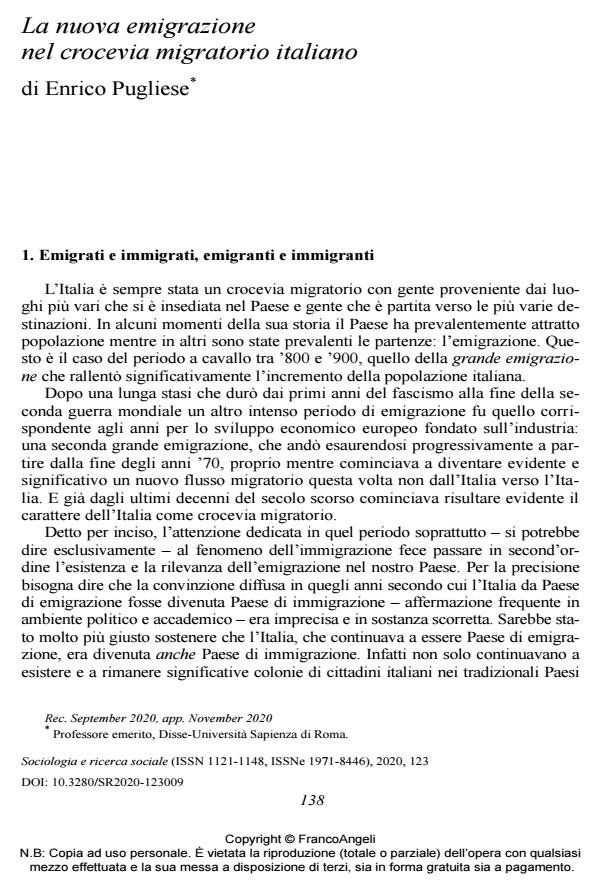The new emigration in the Italian migratory crossroad)
Journal title SOCIOLOGIA E RICERCA SOCIALE
Author/s Enrico Pugliese
Publishing Year 2020 Issue 2020/123 Language Italian
Pages 12 P. 138-149 File size 212 KB
DOI 10.3280/SR2020-123009
DOI is like a bar code for intellectual property: to have more infomation
click here
Below, you can see the article first page
If you want to buy this article in PDF format, you can do it, following the instructions to buy download credits

FrancoAngeli is member of Publishers International Linking Association, Inc (PILA), a not-for-profit association which run the CrossRef service enabling links to and from online scholarly content.
Italy is a true migratory crossroad, with a comparable number of Italian citizens living abroad, and of foreigners living in the peninsula. This decade’s novelty is a renewed emigration from Italy, with very different characteristics from those of post-war intra-European migration. This difference is due to the flow’s social composition (previously proletarian, currently mixed); to the higher level of education (even if only about one fourth are graduates); to a female component moving in autonomy and not as an accompanying family member; to the regional origin not only tied to traditionally poor areas; to the fact that work continues to be the most important motivator, although there are many non-economic reasons. The article illustrates these new features and the factors that determine them.
- G. Alberti (2016), «A New Status for Migrant Workers”, Mondi Migranti, 3, pp. 33-49.
- F. Bettio, A. Simonazzi, P. Villa (2006), «Changes in Care Regimes and Femal Migration: The Care Drain in the Mediterranean», Journal of European Social Policy, 163, pp. 271-85.
- C. Bonifazi (2013), L’Italia delle migrazioni, Bologna, il Mulino.
- Istat (2019), Indagine conoscitiva in materia di politiche dell’immigrazione, relazione al Parlamento del Presidente in carica G.G. Blangiardo (settembre 2019)
- M. Cevoli, R. Ricci (2016), Le nuove migrazioni italiane, in E. Galossi (a c. di), VIII Rapporto Ires su Immigrazione e sindacato, Roma, Ediesse.
- Istat (2017), Migrazioni internazionali e migrazioni interne della popolazione residente, Report Anno 2016, Roma.
- E. Pugliese (2018), Quelli che se ne vanno. La nuova emigrazione italiana, Bologna, il Mulino.
- E. Pugliese, E. Rebeggiani (2019), «Buio a Mezzogiorno», Inchiesta, 205, pp. 72-88.
- A. Sanguinetti (2016), «La nuova migrazione italiana in Germania. In fuga dalla crisi», Mondi Migranti, 3.
- A. Sanguinetti (2019), «La transizione migratoria italiana negli anni della crisi», Rivista delle politiche sociali, 2, pp. 25-42.
- G. Standing (2012), Precari, Bologna, il Mulino.
- Svimez (2017), Rapporto sull’economia del Mezzogiorno, Bologna, il Mulino.
- M. Tirabassi (2018), «Migranti da sempre», Il Mulino, 6, pp. 24-32.
- M. Vitiello (2019), «Prima gli Italiani», Rivista delle politiche sociali, 2, pp. 85-102.
Enrico Pugliese, La nuova emigrazione nel crocevia migratorio italiano in "SOCIOLOGIA E RICERCA SOCIALE " 123/2020, pp 138-149, DOI: 10.3280/SR2020-123009